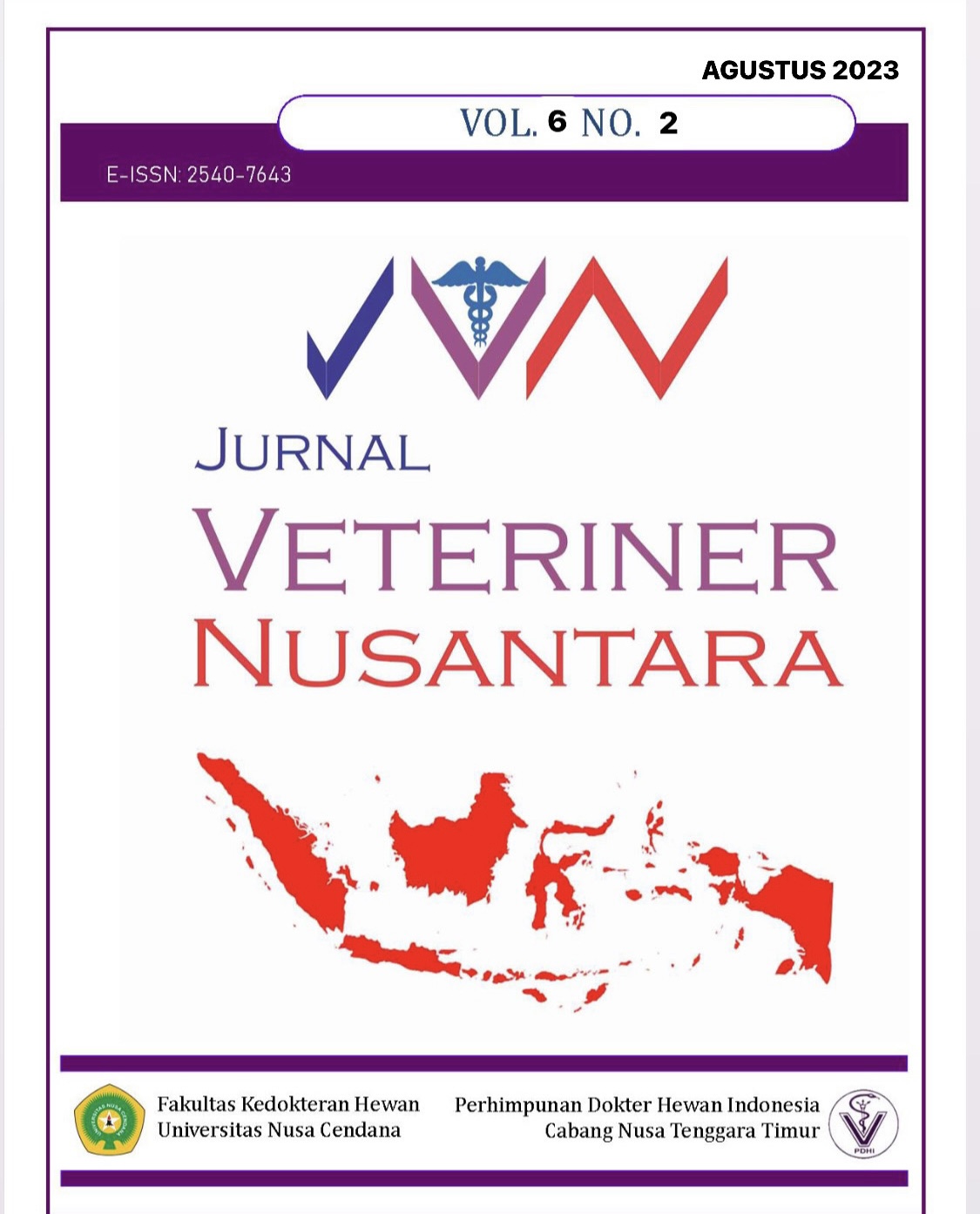Morfologi Kelenjar Parotis Dan Mandibularis Babi Timor (Sus scrofa domesticus)
Abstract
Timor pig (Sus scrofa domesticus) is classified as one of local Indonesia pigs breed of Sus scrofa. Salivary glands had huge contribution to the digestive system. This research aimed to identify the gross anatomy and histomorphology of the parotid and mandibular glands in Timor pigs. Five samples were taken from Atambua slaughter house. Observation of gross anatomy were carried out directed in slaughter house. Then, the glands were fixated in 10% formalin and stained with HE. The results showed the parotid gland was located on the ventral of the auricle and stretched superficially along the caudal masseter muscle to the caudal of the lower jaw. The parotid gland had brown triangle-shape lobules. The mandibular gland was located in the caudal of the lower jaw or profundus of the parotid gland and had pinkish irregular-shape with rounded edges. The asinar cells of the parotid gland were dominated by serous acini with pyramid-like cells. Serous cells were round-shaped in center of cell membrane. Other serous cells called special serous cells were round-shaped pressed into basal of cell membrane. The asinar cells of the mandibular gland were dominated by mucous acini and discovered serous acini and serous demilune. Pyramid-like mucous cells had flat nucleus in basal of cell membrane. Pyramid-like serous cells had round nucleus in center of cell membrane. Serous cell that arranged in peripheral mucous acini will form into serous demilune. The ducts on the parotid and mandibular glands comprised of the intercalated ducts, the striated ducts and the excretory ducts.
Downloads
References
Banks WJ. 1993. Applied Veterinary Histology-Third Edition. St. Louis Missouri: Mosby, Inc.
Boshell JL, Wilborn WH. 1978. Histology and Ultrastructural of The Pig Parotid Gland. American Journal of Anatomy, 152:447-465.
Debi M, Sarma AJ. 2020. Comparative Histology of Parotid Glands in Mammals. India: Journal of Evidence Based Medicine and Healthcare, 7(30):1495-1500.
Eurell JA, Frappier BL. 2006. Dellman's Textbook of Veterinary Histology-Sixth Edition. Iowa: Blackwell Publishing.
Hofmann RR. 1989. Evolutionary Steps of Ecophysiological Adaptation and Diversification of Ruminants: A Comparative View of Their Digestive System. Oecologia, 78: 443-457.
Kay RNB. 1987. Weights of Salivary Glands in Some Ruminant Animals. Journal of Zoology London, 211: 431- 436.
Kim JJ, Khan WI. 2013. Goblet Cells and Mucins: Role in Innate Defence in Enteric Infection. Canada: Pathogens, 2:55-70.
Mescher, AL. 2009. Histologi Dasar JUNQUEIRA: Teks dan Atlas Edisi 12. Jakarta: Penerbit Buku Kedokteran EGC.
Siagian PH. 1999. Manajemen Ternak Babi. Bogor: Jurusan Ilmu Produksi Ternak. Fakultas Peternakan, Institut Pertanian Bogor.
Stambirek J, Kyllar M, Putnova I, Stehlik L, Buchtova M. 2012. The Pig as An Experimental Model for Clinical Craniofacial Research. Laboratory Animals. 46:269-279.
Triakoso N. 2019. Buku Ajar Penyakit Dalam Veteriner Ruminansia, Kuda Dan Babi. Surabaya: Airlangga University Press.
Wang SL, Li J, Zhu XZ, Sun K, Liu XY, Zhang YG. 2014. Siolographic Characterization of The Normal Parotid Gland of The Miniature Pig. Dentomaxillofacial Radiology, 27(3).
Zhang X, Li J, Liu XY, Sun YL, Zhang CM, Wang SL. 2005. Morphological Characteristics of Submandibular Glands of Miniature Pig. Chinese Med J-Peking, 73(18):1368.
Zhou J, Wang H, Yang G, Wang X, Sun Y, Song T, Zhang C, Wang S. 2010. Histological and Ultrastructural Characterization of Developing Miniature Pig Salivary Gland. Beijing: The Anatomical Record, 293:1227-1239.
Copyright (c) 2023 Filipe Mali Dos Santos, Inggrid T Maha, Yeremia Y Sitompul, Filphin A Amalo

This work is licensed under a Creative Commons Attribution-ShareAlike 4.0 International License.

 Filipe Mali Dos Santos(1*)
Filipe Mali Dos Santos(1*)



 Visit Our G Scholar Profile
Visit Our G Scholar Profile




